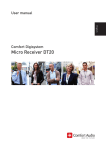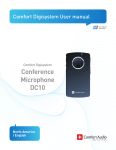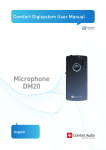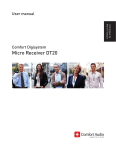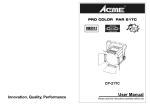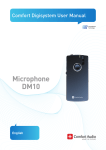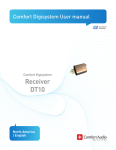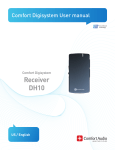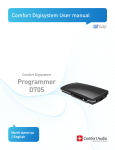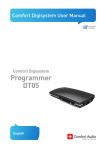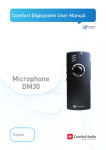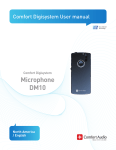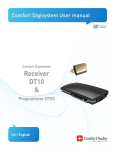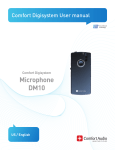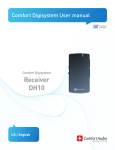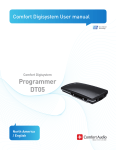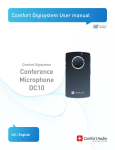Download Micro Receiver DT20
Transcript
User manual North America English Comfort Digisystem Micro Receiver DT20 User manual Table of contents Page 1) Regulatory information 3 2) Introduction Comfort Digisystem 4 3) Overview - Micro Receiver DT20 4 4) Check the hearing instruments input 4 5) Getting started 5 6) Acoustic indication, sound signals 5 7) Modes in the Micro Receiver DT20 6 8) Output for user with different input types and programs in the hearing instrument 6 9) Pairing 8 10) Trouble shooting 9 11) Technical data 12) Service and warranty 9 10 13) Radio range and channels 10 14) Important safety instructions 11 Micro Receiver DT20 2 1) Regulatory information Comfort Digisystem products are not to be used as a substitute to the hearing aids and should be used in accordance with the specifications and recommendations provided by your physician. WARNING! Changes or modifications not expressly approved by the party responsible for compliance could void the user’s authority to operate the equipment. NOTE! Max output > 130 dB SPL (Sound Pressure Level). Could be very dangerous for your hearing. It is recommended that customers keep the volume control in the lowest position, when turning on the device. If not, the sound could potentially cause harm to the customers’ hearing. NOTE: This equipment has been tested and found to comply with the limits for a Class B digital device, pursuant to Part 15 of the FCC Rules. These limits are designed to provide reasonable protection against harmful interference in a residential installation. This equipment generates, uses and can radiate radio frequency energy and, if not installed and used in accordance with the instructions, may cause harmful interference to radio communications. However, there is no guarantee that interference will not occur in a particular installation. If this equipment does cause harmful interference to radio or television reception, which can be determined by turning the equipment off and on, the user is encouraged to try to correct the interference by one or more of the following measures: -- Reorient or relocate the receiving antenna. -- Increase the separation between the equipment and receiver. -- Connect the equipment into an outlet on a circuit different from that to which the receiver is connected. -- Consult the dealer or an experienced radio/TV technician for help. Comfort Audio is not liable for damages arising from usage of the equipment not in accordance with the instructions provided by Comfort Audio. Comfort Audio shall not be liable for performance problems and/or damages caused in any way by customer’s modification of any part of the equipment. Federal Communications Commission Statement, This device complies with part 15 of the FCC Rules. Operation is subject to the following two conditions: (1) this device may not cause harmful interference, and (2) this device must accept any interference received, including interference that may cause undesired operation. Programmer DT20 - IC: CAN RSS-Gen/CNR-Gen Industry Canada, This device complies with Industry Canada licence-exempt RSS standard(s). Operation is subject to the following two conditions: (1) this device may not cause interference, and (2) this device must accept any interference, including interference that may cause undesired operation of the device. Le présent appareil est conforme aux CNR d’Industrie Canada applicables aux appareils radio exempts de licence. L’exploitation est autorisée aux deux conditions suivantes : (1) l’appareil ne doit pas produire de brouillage, et (2) l’utilisateur de l’appareil doit accepter tout brouillage radioélectrique subi, même si le brouillage est susceptible d’en compromettre le fonctionnement. Model: Programmer DT20 IC: CAN RSS-Gen/CNR-Gen Model: Micro Receiver DT20 IC: CAN RSS-Gen/CNR-Gen DANGER! DO NOT USE the COMFORT DIGISYSTEM products if you have a PACEMAKER or other implanted device. The Comfort Digisystem products could cause the pacemaker or other implanted device to malfunction and cause serious injury or death. Micro Receiver DT20 3 2) Introduction to the Comfort Digisystem Thank you for choosing Comfort Digisystem. Our products are easy to use and give you crystal clear sound. Before using the product, please read this manual carefully. The Comfort Digisystem products feature SecureStream Technology – a unique, patented digital technology allowing eavesdrop-secure radio transfer in real time. Comfort Digisystem Micro Receiver DT20 The Comfort Digisystem Micro Receiver DT20 is a digital mini receiver that you can easily connect to any hearing aid with a standard three-pin Europlug audio shoe. The receiver weighs 0,04 oz (1,1 g) and is powered by the hearing instrument’s battery. To minimize energy consumption, the mini receiver is equipped with an optional auto-sleep feature. Together with existing microphones and receivers in the Comfort Digisystem assortment, the Micro Receiver DT20 provides clear speech perception. The Micro Receiver DT20 is the world’s first digital mini receiver, taking full advantage of digital technology in enabling outstanding sound reproduction. The optional professional tool Programmer DT20 can be used to configure the Micro Receiver DT20. The Programmer DT20 also makes it easy to test the Micro Receiver DT20 with or without a hearing instrument. 3) Overview - Micro Receiver DT20 Europlug For connecting to the audio shoe on a hearing instrument or to the socket on the Programmer DT20. Push-button For toggling between different listening modes and activating pairing mode. 4) Check the hearing instruments input To be able to use the Micro Receiver DT20, check if — and how — the hearing instrument supports the use of a mini receiver: 1. The hearing instrument must be equipped with an audio shoe with a powered Europlug socket made for mini receiver use. This connects the Micro Receiver DT20 to the hearing instrument and also supplies the DT20 with power from the hearing instrument’s battery. The received audio signal will then be transferred from the Micro Receiver DT20 to the hearing instrument through the audio shoe. 2a. If the hearing instrument is equipped with a Programmable DAI input (DPAI), programming of the hearing instrument might be necessary (check with audiologist or hearing instrument manufacturer). In this case the push-button on the Micro Receiver DT20 cannot switch between the R and R+M modes. This is instead done by using different listening programs in the hearing instrument. DT20 Europlug TIP! The volume of the Micro Receiver DT20’s R and R+M mode can be set individually by using the Programmer DT20. This makes it possible to use the push-button as a simple volume control in combination with a hearing instrument with Programmable DAI input (DPAI). Micro Receiver DT20 4 2b. If the hearing instrument is equipped with a DAI input (check with audiologist or hearing instrument manufacturer), no programming of the hearing instrument is necessary. The Micro Receiver DT20 works with the Microphone (M) listening program on your hearing instrument. By setting up the Micro Receiver DT20 with the Programmer DT20, the push-button on the Micro Receiver DT20 can be used to select the listening mode: Radio only (R mode) or Radio + Hearing instrument microphone (R+M mode). DT20 Europlug 5) Getting started Connect the Micro Receiver DT20 to the audio shoe on the hearing instrument. Check that the audio shoe is connected to the hearing instrument according to the manufacturer’s instructions. Make sure that the Micro Receiver DT20 is fitted in the correct manner and push the Euro-plug completely into the socket of the audio shoe. The Micro Receiver DT20 is powered by the hearing instrument’s battery. Make sure that the battery is fresh. If you are unsure, replace the battery. Briefly press the push-button on the Micro Receiver DT20 to turn it on or off. (If the Micro Receiver DT20 has been programmed to the mode Always on, it will start automatically when it’s connected to the hearing instrument. The on/off function of the push-button is then disabled.) 6) Acoustic indication, sound signals The following is a description of the acoustic indications (sound signals). The sound signals consist of various combinations of two different tones: one high pitch tone (1000 Hz) and one low pitch tone (500 Hz), and two different tone lengths. Action:Sound signal:Indicate this: • Button pressed briefly Short high pitch Selecting mode or turning on •• Button pressed briefly Short high pitch x 2 — Turning off + long low pitch • • Button pressed 2 sec. Short low pitch Pairing mode + short high pitch •• Pairing Short high pitch x 2 Successful pairing — Pairing Long high pitch — Pairing failed + long low pitch Micro Receiver DT20 5 7) Listening modes in the Micro Receiver DT20 The available listening modes in the Micro Receiver DT20 can be setup in different configurations: R Default setting R+M Setup with Programmer DT20 is necessary R and R+M Setup with Programmer DT20 is necessary The Programmer DT20 is used to configure and enable or disable different listening modes in the Micro Receiver DT20. The push-button on the Micro Receiver DT20 is used to toggle between the activated listening modes. It is also possible to disable the push-button completely. 8) Output for user with different input types and programs in the hearing instrument Different hearing instrument electrical input types and available programs in the hearing instrument will result in different output for the user. Output for the user is shown in the white sections of the charts below. Micro Receiver DT20 with R mode enabled (default setting) The chart below shows the output (what the user can hear) when Micro Receiver DT20 listening mode R is enabled in combination with different input types and programs in the HI. When pressing the push button on the Micro Receiver DT20, the listening mode is shifted in the following sequence: Micro Receiver DT20 push-button Off R mode Off Radio only Off Radio + HI microphone Off Radio only Hearing instrument: DAI input Programmable DAI input (DPAI) DAI + M program Programmable DAI input (DPAI) DAI program only Micro Receiver DT20 6 Micro Receiver DT20 with R+M mode enabled and R mode disabled The chart below shows the output (what the user can hear) when Micro Receiver DT20 listening mode R+M is enabled, in combination with different input types and programs in the HI. When pressing the push-button on the Micro Receiver DT20, the listening mode is shifted in the following sequence: Micro Receiver DT20 push-button Off R+M mode Off Radio + HI microphone Off Radio + HI microphone Off Radio only Hearing instrument: DAI input Programmable DAI input (DPAI) DAI + M program Programmable DAI input (DPAI) DAI program only Micro Receiver DT20 with both R and R+M modes enabled The chart below shows the output (what the user can hear) when Micro Receiver DT20 listening modes R and R+M both are enabled, in combination with different input types and programs in the HI. When pressing the push-button on the Micro Receiver DT20, the listening mode is shifted in the following sequence: Micro Receiver DT20 push-button Off R mode R+M mode Off Radio only Radio + HI microphone Off Radio + HI microphone * Radio + HI microphone * Off Radio only * Radio only * Hearing instrument: DAI input Programmable DAI input (DPAI) DAI + M program Programmable DAI input (DPAI) DAI program only * When using this setup in combination with Programmable DAI input (DPAI), the level of the two modes (R+M and R) can be programmed individually to serve as a volume control. Note! Difference in volume can occur When using a hearing aid with Programmable DAI input (DPAI) and having both R and R+M modes in the Micro Receiver DT20 enabled there can be a difference in volume between the R and R+M modes even if the Micro Receiver DT20 has been programmed with identical output levels for the two modes. The reason for this difference is that the output level in the Micro Receiver DT20 is affected by the input impedance of the hearing instrument. The difference in output level can vary between different hearing instruments - usually the output level will be slightly higher in the R+M mode. An adjustment might be done with the Programmer DT20 in order to meet the users requirements. Micro Receiver DT20 7 9) Pairing The Micro Receiver DT20 can receive but not transmit pairing information. To pair the Micro Receiver DT20 with your Comfort Digisystem transmitter the Micro Receiver DT20 must be connected either to your hearing instrument or to the Programmer DT20. Press the push-button on the Micro Receiver DT20 for 2 seconds to activate pairing mode. When pairing mode is activated, you receive an acoustic indication: • • Send the pairing information within 15 seconds. To interrupt pairing mode, briefly press the push-button. Example 1: Pairing a Micro Receiver DT20 into an existing Comfort Digisystem consisting of one Conference Microphone DC10 and one Receiver DH10: 1. Connect the Micro Receiver DT20 to the hearing instrument’s audio shoe according to the instructions. 2. Initiate pairing mode in the DT20 by pressing the push-button for 2 seconds. Acoustic indication: • • 3. Start the Conference Microphone DC10. 4. Rapidly press the pairing button on the DC10 twice. The display on the DC10 responds with the text “Info sent”. 5. The Micro Receiver DT20 confirms success ful pairing with an acoustic indication: • • Example 2: Make a new eavesdrop secure configuration with one Microphone DM10 and two hearing instruments with Micro Receiver DT20s: 1. Connect the Micro Receiver DT20s to the hearing instrument’s audio shoes according to the instructions. 2. Activate pairing mode in the two DT20’s by pressing the push-buttons for 2 seconds. Acoustic indication: • • 3. Start the Microphone DM10 and open the menu. Select Communication/Pairing/New code key and answer Yes if you want to create a new code key and transmit it. 4. The Micro Receiver DT20s confirm success ful pairing with an acoustic indication: • • Example 3: Make a new eavesdrop secure configuration with one Microphone DM10 and two Micro Receiver DT20s using the Programmer DT20: 1. Put one of the Micro Receiver DT20s into the Programmer DT20. 2. Start the Programmer DT20 and connect head phones or a neck loop to be able to listen. 3. Activate pairing mode for the DT20 by pressing the push-button for 2 seconds. In the headphones/neckloop you receive an acoustic indication: • • 4. Start the Microphone DM10 and open the menu. Select Communication/Pairing/New code key and answer Yes if you want to create a new code key and transmit it. 5. The Micro Receiver DT20 confirms success•• ful pairing with an acoustic indication: 6. Remove the paired DT20 and connect the other DT20 into the Programmer DT20. 7. Activate pairing mode on the DT20 by pressing the push-button for 2 seconds. In the headphones/neckloop you receive an acoustic indication: • • 8. Open the menu on the DM10 and select Communication/Pairing/Send info. 9. The Micro Receiver DT20 confirms success ful pairing with an acoustic indication: • • Micro Receiver DT20 8 10) Trouble shooting 11) Technical data Micro Receiver DT20 The receiver does not start 1. Check that the correct listening program is selected on the hearing instrument. 2. Make sure the Micro Receiver DT20 is correctly connected to the hearing instrument’s audio shoe. Also check the connection between the audio shoe and the hearing instrument. 3. Make sure all connecting surfaces are clean. 4. Check/replace the hearing instrument’s battery. 5. Remember to press the push-button briefly to switch the DT20 on. Radio transmission: SST - SecureStream Technology Frequency range: 904 - 927 MHz Range: Approx. 100 feet (30 m) Dimensions: 0.38 x 0.44 x 0.84 inches (9.7 x 11.2 x 21.3 mm) Weight: 0.05 oz (1.1 g) The weights, dimensions, capacities, performance ratings and other data in Comfort Audio’s brochures, prospectus, circulars, advertisements, price lists and instructions sheets are mentioned only as general information. They are only approximate and shall not bind Comfort Audio. Poor speech intelligibility The distance between the transmitter and the receiver may be too long. The range is around 100 feet (30 meters). The distance between the microphone and the talking person may also be too long; move the microphone closer to the talking person. Try changing the channel/environment. Poor range and interference In some environments, such as in buildings with a lot of concrete, iron or sheer metal structures, the range may be reduced. There may also be electronic equipment nearby causing interference. Change the channel. No sound Check that the transmitter and the receiver are set to the same channel. Loud hissing noise Check that the Comfort Digisystem units you are using are paired together. If Auto sleep is enabled, the Micro Receiver DT20 goes into sleep mode if there is no radio signal. But if another radio signal (with the same frequency you are using) is present, the Micro Receiver DT20 might start again automatically. This could cause a loud hissing noise and that’s why Auto sleep should be used with caution. Micro Receiver DT20 9 12) Service and warranty 13) Radio range and channels Warranty extension Comfort Audio Inc. warrants this product sold to the first end user (buyer) against defects in materials or workmanship for the time period and as set forth below. Pursuant to this Limited Warranty, Comfort Audio will, at its own option, either (a) repair the product or the parts determined to be defective, using new or refurbished parts, or (b) provide you with a new, or at our option, a refurbished unit. The repaired or exchanged unit is under warranty for the remainder of the original product’s warranty period. The warranty does not include any other direct, indirect or consequential damage or loss, or any third party damages or losses. This Limited Warranty is for a period of two years from the date of purchase as indicated by an original receipt from a Comfort Audio authorized retailer, dispenser or medical facility. For accessories the warranty period is 90 days as of the date of delivery. The transmitter and receiver have built-in antennas. The radio range between the units varies depending on the product and the particular environment you are in. Like all radio systems, Comfort Digisystem communicates on specific channels. If you use two transmitters on the same channel or a neighbouring one, there may be interference. Other electronic equipment can also interfere with radio transmissions. The channel that you use in your country is perhaps not permitted abroad. Always get in touch with your hearing aid provider in your country in order to find out which channels are permitted in different countries. Comfort Audio is not liable for unauthorized use of radio waves, such as, but not limited to: interferences with police communication, or strategic communication, military installations etc. How to make a warranty claim For warranty service, you must contact the Comfort Audio Customer Service listed below to obtain an RMA (Return Merchandise Authorization) number. A description of the defect, your name, address and telephone number is required. Ship the product freight prepaid via UPS or its equivalent, including a copy of the original purchase receipt, any cables, earphones and base/charger unit, in its original packaging or one that offers equal protection. Insure your shipment for loss or damage. Comfort Audio accepts no liability in case of damage or loss en route to our offices. This Limited Warranty does not cover Damage from misuse, neglect or normal wear and tear. Products that have been modified. Products purchased or serviced outside the territory. If you purchased your product outside the territory, see your retailer for warranty information. Product Registration Please complete, sign and mail the Product Registration Card packed with your unit. It will make it easier to contact you if it ever would be necessary. Comfort Audio Inc. 411 E. Business Center Drive, Suite 109 Mount Prospect, IL 60056, USA To contact the Comfort Audio Customer Service, call (888) 421-0843 or by e-mail [email protected] Micro Receiver DT20 10 14) Important safety instructions Read these before using your product 17) Never use a transmitter or receiver set to a nonpermitted frequency. Check with the frequency authority in the country where the equipment is to be used. 1) Read these instructions. 18) The product contains sensitive electronic equipment and must be handled carefully. 2) Keep these instructions. 19) Never charge product in closed, unaired spaces such as handbags, cases or other closed storage bags. 3) Heed all warnings. 4) FolIow all instructions. 20) Only use batteries and power supply specified by Comfort Audio AB. 5) Do not use this apparatus near water. 6) Clean only with dry cloth. 21) You must not change the battery yourself; please contact your point of purchase. 7) Do not use near any heat sources such as radiators heat registers stoves, or other apparatus (including amplifiers) that produce heat. 22) CAUTION! Danger of explosion if battery is incorrectly replaced. 8) Do not defeat the safety purpose of the polarized or arounding-type plug. A polarized plug has two blades with one wider than the other. A grounding type plug has two blades and a third grounding prong. The wide blade or the third prong are provided for your safety. If the provided plug does not fit into your outlet consult an electrician for replacement of the obsolete outlet. (Only when using polarized plug) 23) The product shall not be exposed to excessive heat such as sunshine, fire or the like. 24) Products include radio transmitters. Do not use products where it is not allowed to use electronic equipment, e.g. on airplanes. 25) The necklace should not be used if there is a risk of getting stuck, e.g. in a machine or other objects. 9) Protect the power cord from being walked on or pinched particularly at plugs convenience receptacles. and the point where they exit from the apparatus. 26) Keep small parts out of reach of children and animals.Choking hazard if swallowed. 10) Only use attachments/accessories specified by Comfort Audio AB. 27) Do not leave the product unloaded for too long, the battery could get damaged. 11) Unplug this apparatus during Iightning storms or when unused for long periods of time. 28) Do not keep the product connected to the charger if it is not used for a longer period. 12) Refer all servicing to qualified service personnel. Servicing is required when the apparatus has been damaged in any way such as power-supply cord or plug is damaged Iiquid has been spilled or objects have fallen into the apparatus, the apparatus has been exposed to rain or moisture does not operate normally or has been dropped. 13) Start listening at a low volume. 14) Too high a volume can seriously damage your hearing. 15) Don’t disassemble the product. 16) Should the product break open because of damage, service should only be done by qualified service personnel. Subject to change Micro Receiver DT20 11 Manufactured by: Comfort Audio AB Local US office: Comfort Audio Inc, 411 E. Business Center Drive, Suite 109 Mount Prospect, IL 60056, USA T (888) 421-0843 [email protected] www.comfortaudio.us MA0466 1304 Comfort Audio AB, Box154, SE-301 05 Halmstad, Sweden Tel. +46 (0)35 260 16 00 Fax +46 (0)35 260 16 50












